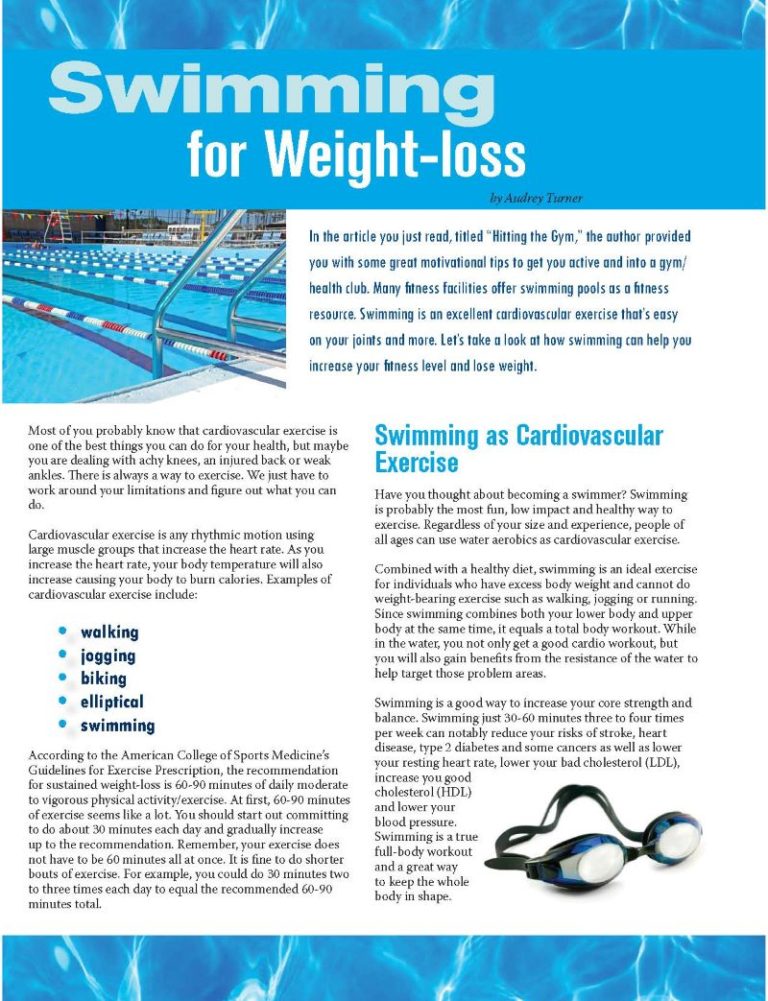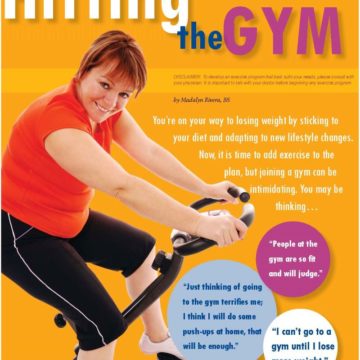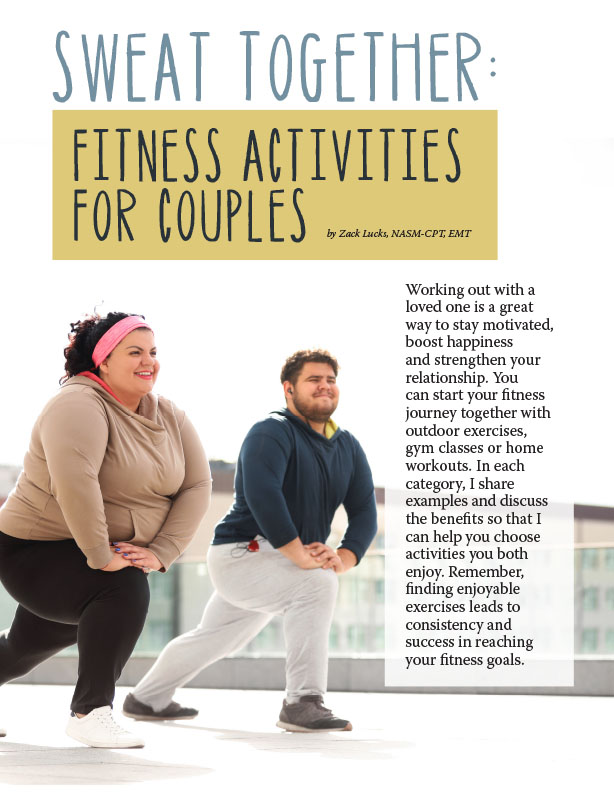Swimming for Weight-loss


by Audrey Turner
Summer 2012
Swimming is an excellent cardiovascular exercise that’s easy on your joints and more. Let’s take a look at how swimming can help you increase your fitness level and lose weight. Most of you probably know that cardiovascular exercise is one of the best things you can do for your health, but maybe you are dealing with achy knees, an injured back or weak ankles. There is always a way to exercise. We just have to work around your limitations and figure out what you can do.
Cardiovascular exercise is any rhythmic motion using large muscle groups that increase the heart rate. As you increase the heart rate, your body temperature will also increase causing your body to burn calories. Examples of cardiovascular exercise include:
- walking
- jogging
- biking
- elliptical
- swimming
According to the American College of Sports Medicine’s Guidelines for Exercise Prescription, the recommendation for sustained weight-loss is 60-90 minutes of daily moderate to vigorous physical activity/exercise. At first, 60-90 minutes of exercise seems like a lot. You should start out committing to do about 30 minutes each day and gradually increase up to the recommendation. Remember, your exercise does not have to be 60 minutes all at once. It is fine to do shorter bouts of exercise. For example, you could do 30 minutes two to three times each day to equal the recommended 60-90 minutes total.
Swimming as Cardiovascular Exercise
Have you thought about becoming a swimmer? Swimming is probably the most fun, low impact and healthy way to exercise. Regardless of your size and experience, people of all ages can use water aerobics as cardiovascular exercise.
Combined with a healthy diet, swimming is an ideal exercise for individuals who have excess body weight and cannot do weight-bearing exercise such as walking, jogging or running. Since swimming combines both your lower body and upper body at the same time, it equals a total body workout. While in the water, you not only get a good cardio workout, but you will also gain benefits from the resistance of the water to help target those problem areas.
Swimming is a good way to increase your core strength and balance. Swimming just 30-60 minutes three to four times per week can notably reduce your risks of stroke, heart disease, type 2 diabetes and some cancers as well as lower your resting heart rate, lower your bad cholesterol (LDL), increase you good cholesterol (HDL) and lower your blood pressure. Swimming is a true full-body workout and a great way to keep the whole body in shape.
Because swimming is non to very-low-impact and a non-weight bearing form of cardiovascular exercise, it makes it very valuable to people who may be struggling with limitations that go along with obesity, range of motion issues and injuries. While in the water, you will also be stretching your muscles and increasing your mobility and you have 80-90 percent less weight pulling and pressing at your bones and joints.
With 80 percent less weight, you are more likely to exercise with less pain; therefore, allowing your workouts to be longer and burning more calories to aid in your weight-loss. Swimming does not cause pressure on your joints and muscles and should not cause the aches and pains that some other types of exercise can cause. This makes swimming a great exercise to help in weight-loss.
Tips for Your Swimming Routine
When designing your swimming routine, remember these important tips:
- Consult with a physician before starting any type of aerobic routine.
- Warm-up and stretch first. You can do this by walking in place, doing arm circles and arm stretches. Warm-up for at least five minutes.
- Start out slow and at your level of fitness. Gradually increase the time to obtain the recommended 60-90 minutes of physical activity/exercise each day.
- Use the pool equipment (noodles, water float weights and float belts) to do water aerobics. This is where you could add a little resistance training into your routine.
Interval Training
Doing intervals is an excellent way to keep your metabolism up long after you finish your exercise. Interval training is when you start out at a slow speed for one to two minutes, then go faster for one to two minutes. Continue to do this routine until you are finished and then do a five minute cool down lap. If you are unable to do the faster pace for a whole minute, just increase the speed for 20-30 seconds and then slow down letting your heart rate come down. Then repeat the intervals.
Swim Regularly
To lose or maintain weight, you must be consistent with your exercise. Exercising once a week isn’t going to cut it. Remember the guidelines mentioned earlier. For sustained weight-loss, you should aim for 60-90 minutes of cardiovascular exercise five to six days per week. Indoor swimming is a modality of exercise that you can be consistent with and do year-round. The most important thing to remember about exercise is to be consistent with whatever type you choose. Start moving and improve your health today!
About the Author:
Audrey Turner is an exercise physiologist at both The Centennial Center for the Treatment of Obesity in Nashville, TN, and Centennial Medical Center Cardiac Rehab where she coaches patients pre and post bariatric surgery, evaluates and educates patients post cardiac stent and surgery, and designs personalized exercise routines.
by Yelena Kibasova Spring 2024 The fitness world is evolving, with new trends and innovations that promise…
Read Articleby Zack Lucks, NASM-CPT, EMT Winter 2024 Working out with a loved one is a great way…
Read Articleby Nina Crowley, PhD, RD (with Inspiration from Shawn Cochran) Winter 2024 Dating, no matter your age,…
Read Article








